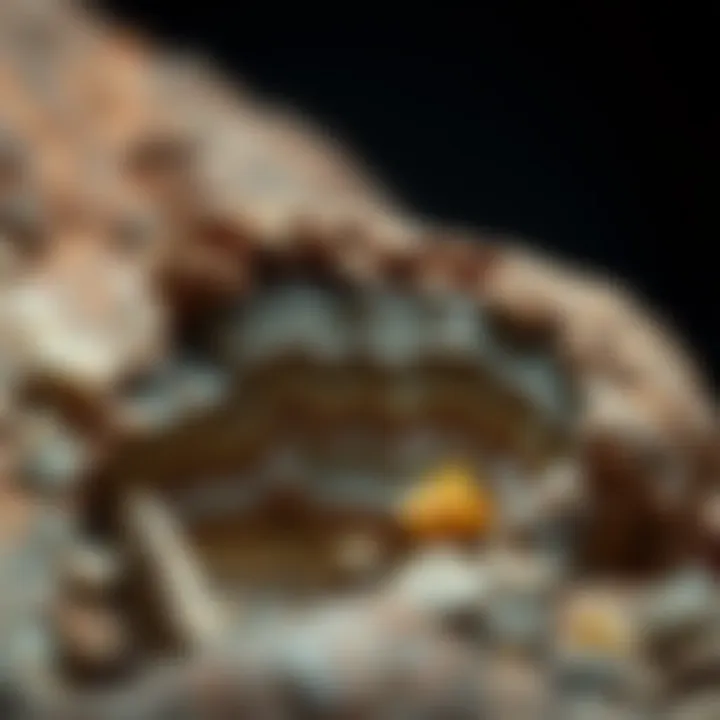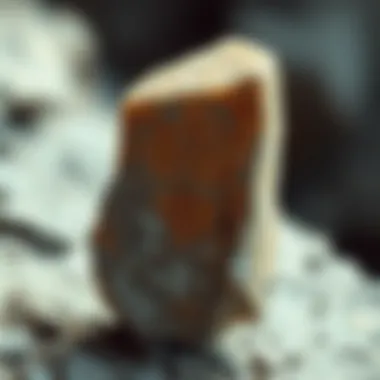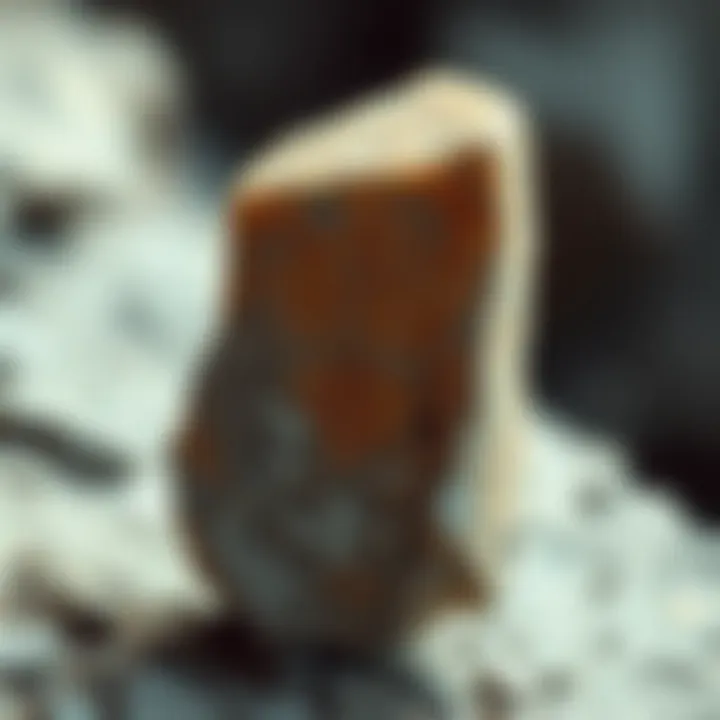Exploring Flint's Unique Properties: A Detailed Guide


Intro
Flint is a remarkable material, often overlooked, yet its properties offer a deep insight into our geological past and its utilitarian value across cultures and epochs. Historically, flint was not just a stone; it was a cornerstone of human progress, enabling early man to create tools that changed the very fabric of society. While today’s modern world has shifted dramatically from the reliance on stone tools, understanding flint's multifaceted properties remains important for enthusiasts and collectors alike.
In this comprehensive guide, we shall unravel the significant aspects of flint. We will journey back in time to see how this material played a pivotal role in human history, delve into the ways to identify various types of flint, and examine its ongoing relevance in contemporary applications. By weaving together historical narratives and scientific analyses, we aim to clarify why flint deserves a place of honor in the art of collecting.
History and Origins
Overview of Collectibles, Rocks, and Fossils
The allure of flint extends beyond its physical properties; it's intertwined with the story of our planet and its inhabitants. When we think of collectibles, many might envision glittering gems or rare fossils, yet flint is a robust candidate that can tell us much about the earth and its former denizens. With roots tracing back into the prehistoric era, flint finds itself in the hands of collectors who appreciate not only its beauty but also its rich backstory.
Flint often forms in sedimentary environments, like chalk deposits, resulting in a variety of shapes and colors. When one holds a piece of flint, they are more than just clutching a stone; they are gripping a piece of ancient history, often riddled with fossilized remnants which can tempt any collector to explore further.
Historical Significance and Cultural Impact
The significance of flint can be seen through the lens of ancient cultures. Tool-making was revolutionized with the discovery of flint knapping, where sharp edges could be created by striking two pieces of flint together. This allowed early humans to craft knives, spearheads, and hunting tools, enhancing their survival in a daunting environment.
Flint tools were not just instruments of daily life; they represented an evolutionary leap in human ingenuity. With each artifact recovered, we gain insight into how our ancestors lived, hunted, and interacted.
In many ancient civilizations, flint also had ceremonial importance. For instance, the Aztecs and Maya utilized flint in religious rituals and offerings, embedding its value deep within their cultures. This ancient stone has traveled through time, influencing the development of human societies across continents.
Identification and Classification
Guide to Identifying Rocks and Fossils
Identifying flint involves a keen eye and an understanding of its characteristic traits. Flint is typically dense, compact, and often has a glassy sheen. Its breakage patterns display conchoidal fractures, a sure sign of its quality and integrity. It is usually found in colors like gray, brown, or black, though variations can present stunning ochre, white, and green hues.
Collectors should keep an eye out for specific features such as:
- Texture: Smooth, glass-like surface indicating a high-quality piece.
- Shape: Often nodular or rounded; some pieces may show human alteration from knapping.
- Fossils: Look for embedded fossil fragments, a clue to its geological history.
Common Types and Variations
Flint isn't just a monolithic type of stone; it comes in various forms and grades. Common types include:
- Chalcedony Flint: Known for its translucent qualities, often used for jewelry.
- Silex: Found primarily in Europe, this variety holds historical importance due to its frequent use in ancient tool-making.
- Hornstone: A type of flint that has a more granular texture and is commonly used in modern applications.
Each type of flint carries with it a narrative, whether it's from a prehistoric era or a modern-day context. Enthusiasts often seek out these variations to complete their collections and connect with the ancient world that shaped our reality today.
Prelims to Flint
Flint is more than just a rock; it’s a material that has woven itself into the very fabric of human history and culture. Understanding flint opens the door to appreciating the ancient technologies that shaped civilizations and their subsequent evolution. This section lays down the groundwork by delving into what makes flint distinct, highlighting its significance across various domains.
Definition and Composition of Flint
Flint is a variety of silica, primarily composed of silicon dioxide (SiO2), often with minor impurities. What sets it apart from other types of silicate minerals is its unique amorphous structure. Unlike crystalline quartz, the arrangement of atoms in flint does not form a regular pattern, which is why it exhibits remarkable properties pertinent to tool-making and other applications.
The colors of flint can vary widely—from grey, black, to even shades of green or brown—depending on the mineral content and the environment from which it originated. Often, one can find flint embedded in chalk or limestone, which underscores its geological journey. Its capacity for conchoidal fracture—where it breaks to produce smooth, curved surfaces—makes it particularly valuable for crafting tools and weapons historically. The combination of high silica content and minimal impurities makes flint hard as nails, standing up to significant wear and tear.
Historical Context and Usage
Flint has a rich tapestry of history, stretching back to prehistoric times. In the stone ages, early humans honed their skills in flint knapping, a process that involves meticulously chipping away at the stone to create sharp edges for tools such as knives, arrowheads, and scrapers. These primitive yet ingenious items were essential for hunting, food preparation, and other survival needs.
Archaeological findings suggest that cultures across the globe, from the Indigenous people of North America to early Europeans and Asians, recognized flint's utility. In fact, many ancient sites reveal caches of flint tools, often near areas that demonstrate high flint concentrations.
"The ancient trades built around flint extraction and tool-making were foundational to early commerce, illustrating how a rock can hold more than just geological significance."
Not to mention, the adaptability of flint meant that as societies progressed, so did its applications. The use of flint even extended to firearms in the form of flintlock mechanisms during the Renaissance, showing that this material has truly been a staple throughout our shared history.
In summary, understanding flint's definition and historical significance is pivotal, as it provides insights into human innovation and adaptation. As we continue through this guide, each aspect explored will enrich our understanding of flint’s role not solely as a geological artifact but as a cornerstone of human development.
Physical Properties of Flint
Understanding the physical properties of flint is like peeling back the layers of an onion—every layer reveals something significant about this remarkable material. Flint's physical characteristics offer insight into its durability, aesthetic appeal, and suitability for various applications, from ancient tools to contemporary design elements. These properties not only provide utility but also enhance its status among collectors and enthusiasts deeply invested in geology and archaeology.
Color Variation and Significance
Flint is often found in a palette of colors, ranging from deep blacks and browns to lighter hues like greys, whites, and even soft pastels. This color variation isn’t just for show; it often indicates the mineral content and formation conditions of the stone. For instance, darker colors might suggest a high iron content, while lighter shades often point to the presence of calcium carbonate.


Collectors cherish flint based on its color because it can denote authenticity and origin. Unique colors can elevate a piece's value and desirability, making them superb conversation pieces. When appraising flint specimens, look closely at these variations as they can tell a story of where the stone was sourced and its journey through time.
"In the eyes of a collector, each color is like a fingerprint—distinct, revealing, and irreplaceable."
Hardness and Durability
Flint is known for its hardness, ranking around 5 to 7 on the Mohs scale, depending on its specific composition. This level of hardness makes flint exceptionally durable, capable of withstanding substantial wear and tear. The durability factor is crucial, especially when considering flint tools used throughout history. It enabled our ancestors to craft tools for hunting, cutting, and even ceremonial purposes — their longevity meant they could be passed down through generations.
Moreover, the durability of flint lends itself beautifully to modern contexts. For construction and design, flint can be used in pathways, buildings, and ornamental gardens. Its resilience against weathering and erosion makes it a solid choice for various applications. Collectors should appreciate that a well-preserved flint specimen can last centuries, providing a tangible link to both geological and anthropological histories.
Texture and Cleavage
When examining flint, texture is another pivotal aspect that offers insight into its formation and usability. Flint's surface is typically smooth with a glassy finish, caused by its fine-grained silica structure. This attribute heightens its aesthetic appeal while facilitating ease of shaping during tool manufacturing.
Furthermore, flint exhibits a unique property known as conchoidal fracture, where it breaks in a curved, shell-like pattern. Understanding this feature is essential for collectors and those wishing to identify flint. The way flint fractures can also hint at how our ancestors might have struck the rock to create tools. A more refined edge, created through careful striking, often results in a sharper tool—exemplifying the skill of prehistoric artisans.
In summary, the physical properties of flint, encompassing its color diversity, remarkable hardness, and unique texture, are more than mere characteristics. They are indications of its geological formation and human interaction, making flint a topic of considerable intrigue for collectors and researchers alike. For further exploration, resources like Britannica’s article on flint and Wikipedia's entry on the subject provide extensive insights that complement this guide.
Chemical Properties of Flint
The chemical properties of flint are fundamental to understanding its behavior, uses, and significance through history. Understanding these properties provides insight not only into flint itself, but also into its role in various applications, from manufacturing to archaeology. Knowledge about the chemical makeup of flint can guide collectors and enthusiasts in identifying genuine pieces as well as assessing their value. This section will explore the silica content of flint and its implications, along with its stability and interactions with other substances.
Silica Content and Its Implications
Flint is primarily composed of silica, a compound made of silicon dioxide (SiO2). This high silica content is what gives flint its remarkable hardness and durability. In fact, flint generally contains about 90% to 98% silica. This property is what allows flint to be shaped and sharpened into tools effectively in the hands of skilled artisans. The reliability of flint tools in prehistoric times cannot be overstated; these tools were pivotal for survival, showcasing how the availability of materials can dictate the advancement of civilization.
Implications for Collectors
For rock and fossil collectors, the silica content isn't just a fascinating scientific fact; it also bears practical importance. A higher silica concentration often indicates a smoother texture and a more refined appearance. When assessing the value of a flint piece, collectors might look for examples featuring high silica to ensure it has the right characteristics to stand the test of time.
In addition, the presence or absence of other minerals can significantly influence color and luster, which may make a particular specimen more desirable. Collecting flint can often feel like a treasure hunt, as the nuances in chemical composition result in stunning variations.
Chemical Stability and Interactions
Flint's chemical stability is another vital property. Its strong silica structure not only offers resistance against weathering but also makes it relatively inert. This stability means that flint can last for thousands of years. Many archaeological sites have yielded flint artifacts that remain virtually unchanged, providing a direct link to our ancestors.
Flint's interactions with environmental elements are limited due to its inert nature, which can sometimes frustrate chemists and archaeologists alike. When exposed to hydrofluoric acid, it will dissolve, but in most natural conditions, it resists degradation and alteration.
"The inert nature of flint ensures that these artifacts can be preserved for posterity, while revealing a history that could have easily been lost."
However, despite its durability, flint is not impervious. In the presence of certain chemicals or under extreme conditions, it can undergo changes. Awareness of these interactions is crucial for collectors who wish to preserve their finds in optimal condition. For instance, prolonged exposure to acidic environments might affect the surface of flint, causing changes in appearance or texture.
For more detailed insights on the chemical structure and composition of flint, you can refer to sources like Britannica or engage with communities such as Reddit that discuss these fascinating topics.
Geological Formation of Flint
Understanding the geological formation of flint is crucial to grasp not only its characteristics but also its longstanding significance in various contexts. Flint, primarily composed of silica, usually forms in sedimentary environments, often influencing both its properties and availability for use in tools and construction. Thus, investigating the origin of flint reveals the intricate interplay between geological processes and human reliance on this ancient material.
Formation Processes
Flint typically comes into existence through a series of geological processes that involve the accumulation of diatoms, radiolarians, and organic material. As sediments settle over millions of years, chemical leaching occurs, leading to the precipitation of silica.
- Biogenic Origin: Many flint deposits originate from microscopic marine organisms. These living beings, like diatoms, build up layers upon layers, and as they're buried under sediment, they contribute to flint formation.
- Chemical Weathering: Another aspect is the chemical weathering of other silicate minerals present in the rock. Over time, these minerals release silica into the surrounding area, creating flint nodules embedded in chalk or limestone formations.
- Cooling of Magmatic Activity: In some rare cases, flint can form from the cooling of magma, where it can solidify into a flint-like texture. This occurs when igneous rocks, subjected to high pressure and temperature, allow silica to precipitate from a melt.
- After these organisms die, their skeletal structures dissolve and later recrystallize to create the solid form we recognize as flint. This crystallization process often includes various minerals, giving flint its diverse appearance.
- The environment plays a significant role during this weathering, as acid rainwater can speed up the dissolution of silica. In contrast, seasonal drying might concentrate minerals, leading to the creation of unique flint formations.
These processes underline the complexity inherent in flint's formation. Understanding these geological dynamics is paramount for rock collectors and researchers as it affects various characteristics of flint, from its hardness to its overall aesthetic.
Depositional Environments
Depositional environments contribute significantly to flint's characteristics, determining not just its location but also its physical properties. Flint typically forms in marine environments, but the details of these settings matter a great deal.
- Marine Sediment Deposits: Most flint is found in chalk or limestone deposits where marine sediments accrue over time. The rich marine ecosystem ensures that silica from living organisms is present in higher concentrations.
- Lithified Seabeds: After sediment deposition, tectonic forces may uplift these seabeds, transforming them into limestone and chalk cliffs visible today. Such geological activities have scattered flint deposits across various regions.
- Freshwater Environments: Interestingly, some flint can also found in river and lake deposits. While not as common, this indicates that the silica-rich materials can travel through different geological settings before settling down to form flint.
- Impact of Erosion: Erosion plays a role in redistributing flint. As landscapes change and sediment gets worn away, new flint deposits can be exposed, making them accessible for collectors and researchers.
Understanding these depositional environments provides a roadmap that highlights both the historical significance and the modern implications of flint. As flint enthusiasts delve deeper into these topics, they uncover a layered narrative intertwined with natural history that enriches their appreciation of this remarkable material.
Archaeological Significance of Flint


Flint is far more than just an interesting rock; its role in human history is profound and enduring. Archaeologists and historians often look at flint for insights into the lifestyles of our ancestors. This durable material has not only been a tool of choice for prehistoric societies but has also shaped our understanding of cultural development.
Flint Tools in Prehistoric Cultures
Throughout the ages, flint has been a pivotal resource for tool-making. Prehistoric peoples expertly shaped this stone, giving birth to a variety of tools essential for survival. The mere act of knapping flint required skill and understanding of the material's properties. Just imagine early humans, sitting around a fire, meticulously crafting tools to hunt or prepare food, showcasing their ingenuity and adaptation to their environments.
These flint tools, often found in archeological digs, provide a window into ancient technologies and societies. Through the study of
- Flint blades: These were used for cutting and processing animals.
- Scrapers: Handy for removing hides or working with other materials.
- Projectile points: Critical for hunting, these tools represent the evolution of early hunting technologies.
The presence of flint tools at various archaeological sites can also suggest trade routes and interactions between different cultures, offering vital clues about our species' social networks.
Role in Human Evolution
The significance of flint goes beyond its utilitarian function; it also marks key milestones in human evolution. The development of complex flint tool-making techniques demonstrates cognitive advancements, allowing early humans to create specialized tools that catered to specific tasks. The Oldowan and Acheulean tool industries, for instance, reflect a growing understanding of material properties and a shift towards more sophisticated engineering.
Moreover, flint tools indicate adaptive strategies that enabled early humans to exploit various environments. This adaptability showcases the role of cultural evolution in shaping human neurological development. Research suggests that the skills involved in tool-making and use contributed to enhanced cognitive abilities, fostering problem-solving skills and social collaboration. Consequently, flint artifacts can be seen as both a representation of our past and a metaphor for the continual evolution of human capability.
"The evolution of flint technology mirrors the evolution of human thought, reflecting our capacity for innovation and adaptation."
In summary, the archaeological significance of flint encompasses not only the tools and technologies that emerged but also the very essence of human progress. As we gather more insights into these ancient artifacts, we enrich our understanding of humanity’s journey and our relationship with the material world.
Modern Applications of Flint
Flint has carved its niche in various aspects of modern life, extending well beyond the historical context in which it was primarily recognized. This section elaborates on how the unique properties of flint still hold relevance today, influencing construction practices and catering to the niche of collector items. Flint's resurgence in popularity in modern applications speaks to its durability and unique aesthetic qualities.
Use in Construction and Industry
Flint’s usage in construction is one of its most practical applications. The strong, durable nature of flint makes it an excellent material for paving, aggregate in concrete mix, and even roofing materials. One of the significant advantages of utilizing flint is its resistance to weathering. Structures built with flint components can endure the test of time under a variety of environmental conditions.
In industry, particularly in the realm of landscaping and decorative purposes, flint is often crushed into finer particles, employed in creating aesthetically pleasing pathways or as drainage material. Several municipalities have adopted flint chips for park paths, providing both functionality and a natural look.
Moreover, flint’s fire-retardant properties contribute to its application in certain types of insulation and fireproof boards, showing versatility across multiple sectors.
Some key points regarding flint in construction and industry include:
- Durability: Resistance to mechanical weathering prolongs the life of structures.
- Aesthetic Appeal: Natural colors and textures enhance architectural designs.
- Sustainability: Eco-friendly resource for modern construction needs.
Flint in Collectibles
In the domain of collectibles, flint is prized for its historical significance and unique characteristics. It serves both as a material with stunning beauty and as a testament to human ingenuity over centuries. Collectors often seek out various forms of flint artifacts and tools, fascinated by the craftsmanship of ancient cultures that fashioned these items.
Antique flint tools are particularly sought after, showcasing a range of styles and variations utilized by prehistoric peoples for survival. The art of knapping, the process of chipping away at flint to produce tools or decorative pieces, remains a deeply respected skill. Collectors often attend workshops to gain insight into both the history and the techniques behind contemporary flint knapping.
In the digital age, communities on platforms like Reddit have sprung up, enabling enthusiasts to share their collections and knowledge. Posting images of flint collectibles not only fosters a sense of community but also opens discussions about provenance, restoration, and value, resulting in a collaborative learning atmosphere.
"The beauty of flint lies not just in its appearance, but in the stories it tells of human innovation and the natural world."
For collectors, the future holds many possibilities, whether in acquiring rare artifacts or participating in local hunts and excavations to find flint in historical sites.
Collecting flint also presents some practical considerations, such as understanding its value and maintaining proper care of items in one’s collection, ensuring they remain preserved for future generations.
Epilogue of Modern Applications
The modern applications of flint, from construction materials to collectibles, underline its enduring legacy in both functional and aesthetic contexts. As the landscape continues to evolve, so too does the use and appreciation for this diverse material, making it an essential aspect of modern life.
Care and Maintenance of Flint Collectibles
Taking care of flint collectibles is not just a chore; it’s essential for preserving their historical relevance and aesthetic charm. Flint holds a special place in the hearts of collectors because of its beauty and the stories it carries from ages past. Proper care ensures these treasures remain in excellent condition, providing joy to both the collector and future generations.
Being a natural material, flint can be susceptible to scratches, dirt, and environmental factors if not maintained correctly. Hence, understanding the correct methods of cleaning and storing enhances the longevity and visual appeal of these artifacts.
Cleaning Techniques
When it comes to cleaning flint collectibles, one must be cautious. The last thing you want is to chip or damage the very artifacts you cherish. Here are some effective, gentle methods for cleaning flint:
- Soft Brush: Using a very soft toothbrush can be your best friend. Gently brush away dust, dirt, or debris from the surface. This technique is safe and effective, as it minimizes the risk of scratches.
- Water Rinse: For flint items that have visible residue, you can use lukewarm water. Submerge the flint briefly and softly scrub with a cloth. Avoid soaking as excess water may seep into crevices, potentially compromising structural integrity.
- Mild Soap Solution: If there are stubborn stains, mix a small amount of mild dish soap with water. Apply this solution with a cloth and gently wipe the area. Rinse thoroughly with water. Remember—less is more when it comes to soap!
- Avoid Harsh Chemicals: Never use bleach or any strong chemical cleaners, as these can strip away the original luster and even cause discoloration.
Storage Recommendations


Storing your flint collectibles properly is just as vital as cleaning them. Improper storage can lead to chips, scratches, or even breakage over time. Consider these storage tips:
- Display Cases: Showcasing your flint in a display case can protect it from dust while allowing you to admire it. Choose cases with UV-filtering glass to avoid sun damage.
- Soft Padding: For pieces that aren’t displayed, ensure they’re wrapped in soft cloth or placed in padded containers. This prevents them from bumping against each other and causing harm.
- Temperature Control: Store your collectibles in a climate-controlled environment to prevent thermal fluctuations. Extreme changes in temperature and humidity can lead to unseen damage over time.
- Avoid Direct Sunlight: Even when stored, keep these objects out of direct sunlight. It can fade colors and also bring about cracking over years.
- Regular Check-Ups: Periodically, inspect your collection. This habit can help catch any issues early before they escalate into serious damage.
"A little TLC goes a long way in preserving the stories flint has to tell."
Maintaining the care of your flint collectibles is a task that demands attention but is incredibly gratifying. A well-cared-for piece doesn’t merely represent a moment in time; it continues to connect you to the rich history of humanity and our interaction with the natural world. For more in-depth steps on flint care, visit Wikipedia - Flint.
In summary, always approach the cleaning and storage of flint collectibles with a gentle hand. Enjoy the process of caring for these pieces of history, knowing that your effort contributes to the preservation of their legacy.
Identifying Genuine Flint
Identifying genuine flint is an essential aspect for rock and fossil collectors. With its historical significance and numerous practical applications, knowing how to distinguish authentic flint from imitations is fundamental. Since flint is often confused with other similar-looking materials, the ability to accurately identify it can save enthusiasts both time and money, and ensure that their collections reflect true geological specimens. Moreover, understanding these properties can deepen one’s appreciation for this remarkable stone and its rich heritage.
Visual Characteristics
When it comes to visual characteristics, genuine flint boasts a unique set of features that set it apart from other stones. Notably, the color can vary widely; typically, it might present itself in shades of grey, black, or even deep browns. Sometimes, you may even spot flecks of white or rust, signifying the presence of impurities or fossils embedded within.
Another distinguishing factor is the luster. Flint often has a glassy sheen, especially after being freshly fractured. This attribute can catch the eye, making flint stand out in a collection, but it might also tempt the untrained eye to mistake it for a synthetic product.
Additionally, the texture plays an important role. Genuine flint is characterized by a smooth, almost waxy feel, yet it can also contain small surface irregularities that hint at its natural formation process. This smoothness is often contrasted by the presence of sharp edges and conchoidal fractures, which are crucial identifiers of genuine specimens.
Field Tests for Authenticity
If visual tests alone aren't conclusive, several field tests can provide robust evidence of authenticity for flint enthusiasts. One of the most straightforward methods involves the scratch test. Genuine flint is hard and will not easily scratch when rubbed against glass. If a specimen shows scratches, it's likely not true flint.
Another practical test is the spark test. When struck against metal, genuine flint produces a distinct spark due to its silica content. In contrast, synthetic stones may not produce any sparks at all or may fizzle out without the characteristic brightness.
Lastly, performing a weight test can also help. Flint is relatively dense for its size. A genuine piece of flint will typically weigh more than its counterparts made from other similar-looking materials. If the stone feels lighter than it should, that could be a red flag.
"A discerning collector knows - the key to a worthy collection is authenticity, and genuine flint carries with it a story not only of the Earth but of human ingenuity."
By utilizing these visual characteristics and field tests, collectors can become adept at recognizing genuine flint. This proactive approach not only enhances the integrity of their collections, but it also fosters a deeper connection with this remarkable natural material.
Future of Flint Research
The examination of flint is not merely about appreciating its past; it is also about unforeseen potentials that can be unwrapped through ongoing research. This section sheds light on the future of flint research, delving into critical advancements and the ethical considerations entwined with its sourcing and use. In a world that's increasingly resonating with sustainability, the path forward for flint isn't set in stone but rather shaped by innovation and responsibility.
Advancements in Material Science
The field of material science is witnessing rapid evolution, and flint plays a significant role therein. Researchers are uncovering ways to process flint at micro and nano scales, leading to the discovery of new applications that could transform various industries. Such studies focus on the physical structure of flint, examining its properties at microscopic levels and how they can be manipulated for specific purposes.
- Nano-flint Composites: As scientists achieve a deeper understanding, the development of nano-flint composites is on the horizon. These composites can potentially enhance lightweight structural applications due to flint’s admirable hardness and durability.
- Advanced Tool-Making Techniques: Modern production techniques could revolutionize how tools are made, pushing aside traditional methods in favor of precision engineering that leverage flint’s unique characteristics. For example, using 3D printing technology to create flint-based tools might retain the desirable qualities while offering breakthrough efficiency.
As research continues to unfold, partnerships between geologists and material scientists will likely yield newfound benefits, casting light on not only better materials but also sustainable practices.
Sustainability and Ethical Sourcing
In today's climate-conscious society, the emphasis on sustainability and ethical sourcing cannot be ignored. Flint, being a finite resource, raises important questions about its extraction and utilization. Ongoing research looks to address these concerns by investigating responsible mining practices and exploring alternatives that can reduce the pressure on natural flint deposits.
- Alternative Raw Materials: Research into synthetic flint or alternative materials harnessing the same properties can provide substitutes that do not rely on the depletion of natural resources. These alternatives can be crucial in maintaining ecological balance while sustaining demand for flint-like qualities in various products.
- Sourcing Protocols: Implementing strict sourcing protocols that ensure flint is mined responsibly can help maintain environmental integrity. Collaboration with local communities is essential, ensuring that they benefit from the resources without compromising their land or livelihoods.
As we move forward, the conversation surrounding flint must include not only technological advancements but also a genuine commitment to ethical practices. The marriage of material science and sustainability presents a robust platform for the development of new initiatives and ethical standards in the realm of flint.
"Future research will not only augment our understanding but will also dictate how we respect our resources for generations to come."
Finale: The Enduring Relevance of Flint
As we draw the curtain on our exploration of flint, it becomes clear that this ancient material is far from a relic of the past. Instead, it continues to hold substantial relevance in various domains, intertwining historical significance with modern applications. The durability, sharpness, and unique formation of flint not only paint a vivid picture of its geological journey through time but also delineate its pivotal role in human innovation and culture.
Summary of Key Insights
In synthesizing the essential characteristics of flint, several key insights emerge:
- Historical Significance: Flint was instrumental in tool-making, aiding early humans in hunting and survival. The sophistication of flint tools marks a significant evolution in human capability.
- Physical Durability: Its remarkable hardness ensures that flint tools have stood the test of time, often surviving in archaeological contexts where softer materials have degraded.
- Chemical Stability: The high silica content contributes to its resilience against chemical weathering, maintaining its integrity over millennia.
- Modern Applications: Beyond its archaeological value, flint finds new life in modern industries, particularly in construction, as a decorative stone and aggregate.
A careful examination reveals that flint, in all its forms, remains a fascinating subject of both scientific study and practical application.
Implications for Collectors and Enthusiasts
For rock and fossil collectors, flint presents numerous avenues for exploration:
- Variety of Forms: Whether it is in the form of arrowheads, hand axes, or decorative stones, the various types of flint appeal to a wide range of collectors, each piece narrating a unique story.
- Sourcing and Ethics: As collectors hone in on acquiring genuine pieces, it is crucial to consider ethical sourcing. Understanding the geological origins and ensuring sustainable practices can enhance the collector's experience and contribute positively to conservation.
- Educational Opportunities: Knowledge of flint can provide collectors with an edge. Recognizing the different characteristics—such as color, texture, and the way it fractures—can lead to more informed acquisitions.
In summary, flint embodies a blend of history, science, and artistry. For enthusiasts, it is not merely a collection of stones but a window into a world of human ingenuity and natural wonder. Engaging with flint allows collectors not just to own a piece of the past but to participate in a vibrant community dedicated to its appreciation and preservation.



